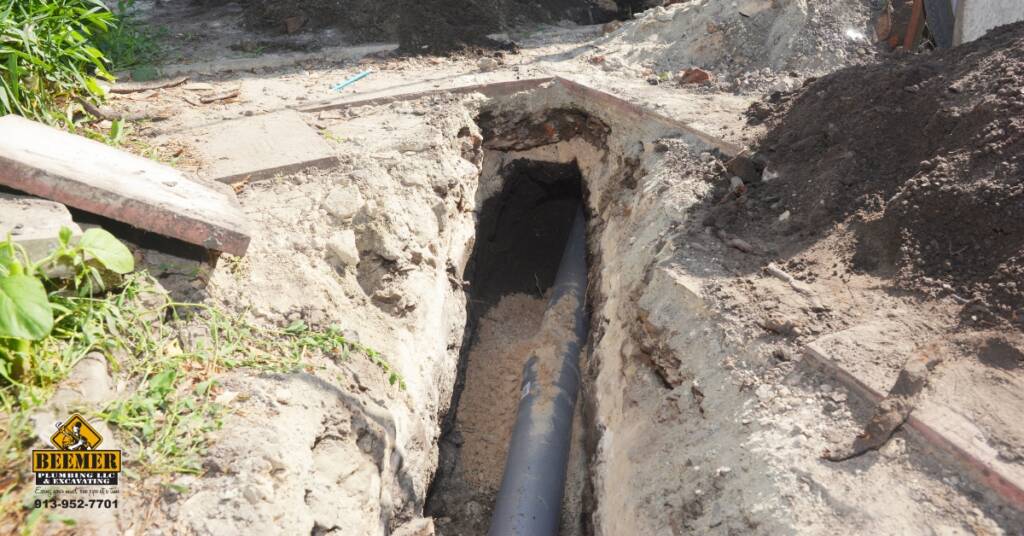Spring is a time for blooming flowers, fresh air—and unfortunately, unexpected sewer line issues for some Kansas City homeowners. As the ground thaws and spring rains increase, aging or compromised sewer lines can be pushed past their limits. At Beemer Plumbing, we’ve seen it all—from tree root invasions to major backups—and we want to help you avoid a messy, stressful plumbing emergency this season. Here’s what you need to know about spring sewer problems—and how to avoid sewer line damage.

How to Avoid Sewer Line Damage
Why Sewer Line Problems Spike in Spring
There are a few key reasons sewer lines become more vulnerable in the spring:
- Thawing soil shifts can put pressure on aging pipes.
- Increased water volume from rainfall and snowmelt tests the system.
- Tree root growth accelerates, looking for moisture and nutrients.
- Ground saturation can slow or stop proper drainage.
Even small issues from winter can escalate quickly as conditions change. That’s why spring is the ideal time for proactive inspection and maintenance.
Common Signs of a Sewer Line Issue
If you notice any of the following warning signs, don’t wait—call a professional plumber right away:
- Slow-draining tubs, sinks, or toilets
- Gurgling sounds from drains or toilets
- Frequent clogs in multiple fixtures
- Unpleasant sewer odors inside or outside
- Soggy patches or unusually green grass in your yard
- Backups in basement floor drains
Any one of these could be an early sign of a blockage, break, or collapse in your sewer line. Ignoring them could lead to extensive property damage and costly repairs.
How to Avoid Sewer Line Damage
Beemer Plumbing recommends these preventative steps for Kansas City-area homeowners:
1. Schedule a Sewer Camera Inspection
Spring is the best time to have your sewer line inspected with a high-resolution camera. This allows us to identify:
- Blockages or grease buildup
- Cracked or collapsed pipes
- Invasive tree roots
- Pipe misalignment or sagging
It’s quick, non-invasive, and gives you peace of mind heading into the rainy season.
2. Be Mindful of Landscaping
Trees with deep, thirsty roots—like silver maples or willows—can infiltrate your pipes over time. Avoid planting them near sewer lines, and if you already have them nearby, consider root barrier solutions or regular hydro-jetting maintenance.
3. Use Water Wisely
Too much water at once can overwhelm your sewer system. During heavy rain:
- Avoid doing laundry or running the dishwasher
- Stagger showers or baths
- Reduce overall water usage
This simple strategy can reduce your risk of backup when the system is already under stress.
4. Install a Backwater Valve
If your home has experienced sewer backups before, a backwater valve is a must. It prevents sewage from re-entering your home by allowing water to flow only one direction—out. It’s especially helpful in older homes or those downhill from main sewer lines.
Pipe Bursting: A Smart Trenchless Repair Option
If we discover your sewer line is cracked, collapsed, or infested with roots, Beemer Plumbing offers pipe bursting—a modern, trenchless repair method that avoids tearing up your yard.
Here’s how it works:
- A new pipe is pulled through the old one, breaking it apart.
- The new pipe is seamless, durable, and root-resistant.
- The process requires only two small access points.
It’s faster, less invasive, and more affordable than traditional dig-and-replace methods—perfect for spring repairs when you want to preserve your landscaping.
When to Call Beemer Plumbing
If you’ve had sewer issues in the past or are noticing any of the symptoms listed above, don’t wait for the next big storm to test your luck. Call us at Beemer Plumbing! Beemer Plumbing offers:
- Sewer camera inspections
- Hydro-jetting and root removal
- Trenchless pipe bursting repairs
- 24/7 emergency service
We proudly serve homeowners across the Kansas City Metro and Johnson County, Kansas, easing your mind—one pipe at a time.